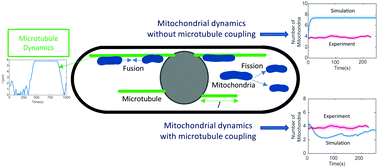Coupling of mitochondrial population evolution to microtubule dynamics in fission yeast cells: a kinetic Monte Carlo study†
Abstract
Mitochondrial populations in cells are maintained by cycles of fission and fusion events. Perturbation of this balance has been observed in several diseases such as cancer and neurodegeneration. In fission yeast cells, the association of mitochondria with microtubules inhibits mitochondrial fission [Mehta et al., J. Biol. Chem., 2019, 294, 3385], illustrating the intricate coupling between mitochondria and the dynamic population of microtubules within the cell. In order to understand this coupling, we carried out kinetic Monte Carlo (KMC) simulations to predict the evolution of mitochondrial size distributions for different cases; wild-type cells, cells with short and long microtubules, and cells without microtubules. Comparisons are made with mitochondrial distributions reported in experiments with fission yeast cells. Using experimentally determined mitochondrial fission and fusion frequencies, simulations implemented without the coupling of microtubule dynamics predicted an increase in the mean number of mitochondria, equilibrating within 50 s. The mitochondrial length distribution in these models also showed a higher occurrence of shorter mitochondria, implying a greater tendency for fission, similar to the scenario observed in the absence of microtubules and cells with short microtubules. Interestingly, this resulted in overestimating the mean number of mitochondria and underestimating mitochondrial lengths in cells with wild-type and long microtubules. However, coupling mitochondria's fission and fusion events to the microtubule dynamics effectively captured the mitochondrial number and size distributions in wild-type and cells with long microtubules. Thus, the model provides greater physical insight into the temporal evolution of mitochondrial populations in different microtubule environments, allowing one to study both the short-time evolution as observed in the experiments (<5 minutes) as well as their transition towards a steady-state (>15 minutes). Our study illustrates the critical role of microtubules in mitochondrial dynamics and coupling microtubule growth and shrinkage dynamics is critical to predicting the evolution of mitochondrial populations within the cell.



 Please wait while we load your content...
Please wait while we load your content...